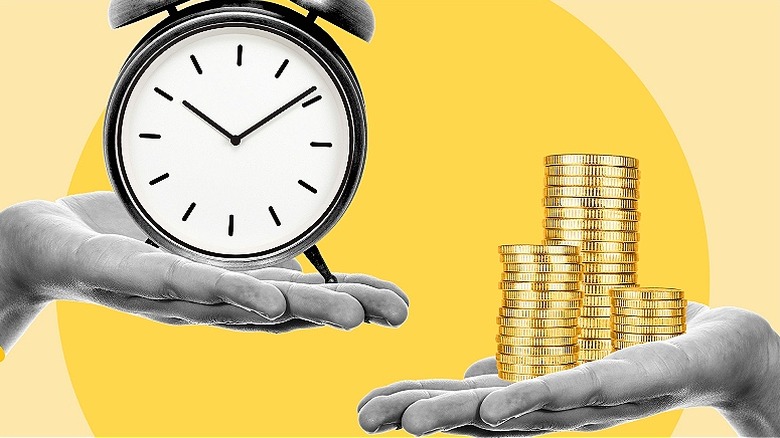Why Time In The Market Almost Always Beats Timing The Market
Executive chairman of Fisher Investments, Kenneth Fisher, once said that "time in the market beats timing the market." The quote is certainly buzzworthy, and the cadence of these words easily sticks in the mind of an investor. But understanding what it means can be a challenge for even some of the most well-disciplined traders. "Timing the market" is constantly a feature that investors try to work into their strategy. After all, a well-timed trade can mean the difference between a healthy return and a wildly successful one, or a major loss versus a sale in the nick of time to stem the bleeding during a market quickly heading toward bear-trading territory (although selling in a down market is a big no-no for high value traders).
We spoke with Joe F. Schmitz Jr. to get to the bottom of this advice. He's the founder and CEO of Peak Retirement Planning and he quickly noted his position on the matter. Alongside most experts in the investment space, Schmitz is an adherent to this fundamental principle of time in the market. The reality is that no trader will be able to gauge the market's rapid movements consistently enough and long enough to effectively take positions or exit holdings in advance of its movements.
Market fluctuation makes short-term predictability difficult
It's not a surprise to anyone, but fluctuations of the stock market still manage to spook investors all the time. Joe Schmitz points out the fact that investing, especially when planning for retirement, is a long-trending exercise, not a jerky or momentum-based task. Market downturns happen on a routine basis. Consider, according to analysis by Capital Group, 27% of the years comprising the last near-century of S&P 500 historical price movement have been in decline overall. Comparing this to 94% of 10-year study periods over that same timeline and the exact same market, it's clear that long-term investing beats out fast-paced trade executions virtually every time.
"The market will at times be down," Schmitz warns, "but you are not losing money unless you sell the investments when they are down." Of course, you may consider selling underperforming stocks as part of a tax-loss harvesting strategy or during a general rebalancing practice that cuts deadweight in favor of freeing up capital. Not every investment you make will be a winner, and sometimes it's better to cut your losses and move on.
However, Schmitz also suggests that investing is more often a waiting game than anything else. "Since the inception of the stock market, the S&P 500 has averaged a return of 10.2%. This doesn't happen without volatility," he said. Fluctuating pricing is what gives investors the ability to buy in with upside potential. "The market will have its bad years, no question," he notes, "but it will also have good years. Holding on to your investments in the bad years allows time for them to average out."
'Timing' yields minimal differences over the long term
The "ability" to time the market is actually a practice in getting lucky rather than a true gift that certain investors might think they can point to. There's absolutely no juice to the idea that some people can effectively time the market on a consistent basis. Professional investors who spend their entire professional lives trying to eke out the best returns possible aren't able to effectively outpace the stock market over the long term, so everyday traders have little hope of achieving this feat. (Speaking of which, these are the best and worst stock predictions in U.S history.)
Even if it were possible to consistently buy in at stock market troughs, according to Capital Group, data over the course of two decades (2004 to 2023) shows an annualized return of 12.64% when purchasing on the best day compared to a 10.78% annualized total return when buying in on the worst. The difference is notable, but it's not nearly as drastic as you might initially think when trying to exploit the fluctuating nature of the stock market's price to maximize your investment profits.
Patience is the biggest obstacle for investors
At the end of the day, it's key to remember that investing in the stock market is a long-term sport. There's no glory in running yourself ragged just to find a tiny little bit more profit on a trade or two. More often than not, you'll end up washing out your good and your bad picks into roughly the same return, regardless of how carefully you try to time the market. As Joe Schmitz told us, "The biggest obstacle is patience." He added that "it can be very difficult to watch your investments fall, but knowing that investing is a long-term play will help you weather uncertainty."
Patience is what sets good and successful investors apart from the pack. Knowing that time in the market ultimately smooths out periods of depressed value, and that buying rather than selling during times of heightened-value opportunity, are the marks of an old hand. Part of this approach, however, lies in allocating invested funds as long-term assets. Putting money you may need in the near future into stocks or other vehicles that can decline in value — perhaps even over a prolonged period — is a great way to find yourself having to sell at a loss. Patience and strategy are two sides of the same coin, and they can make or break your investments.



